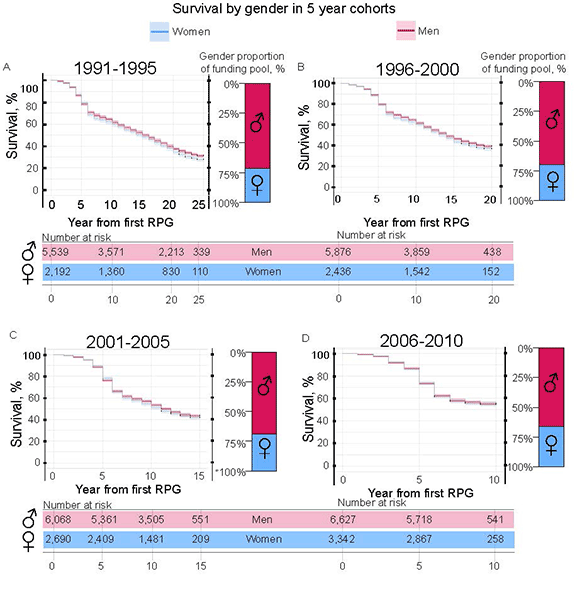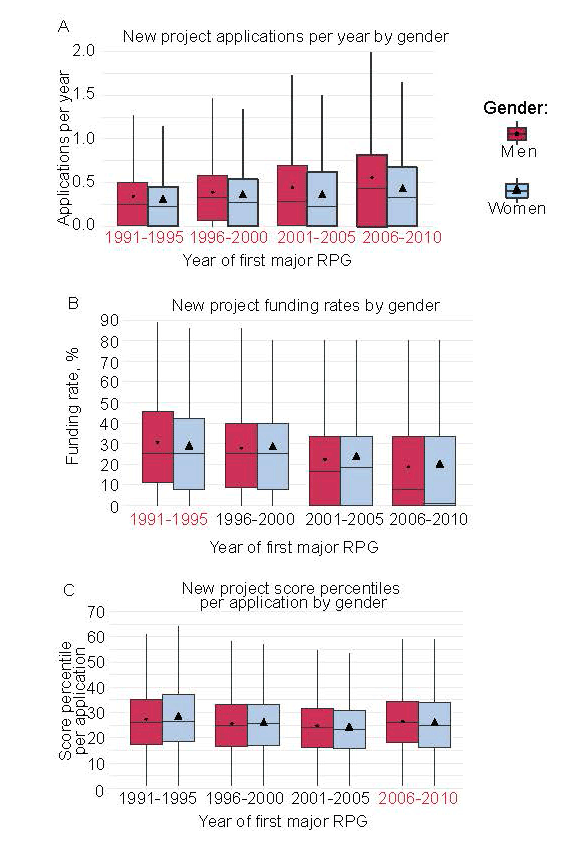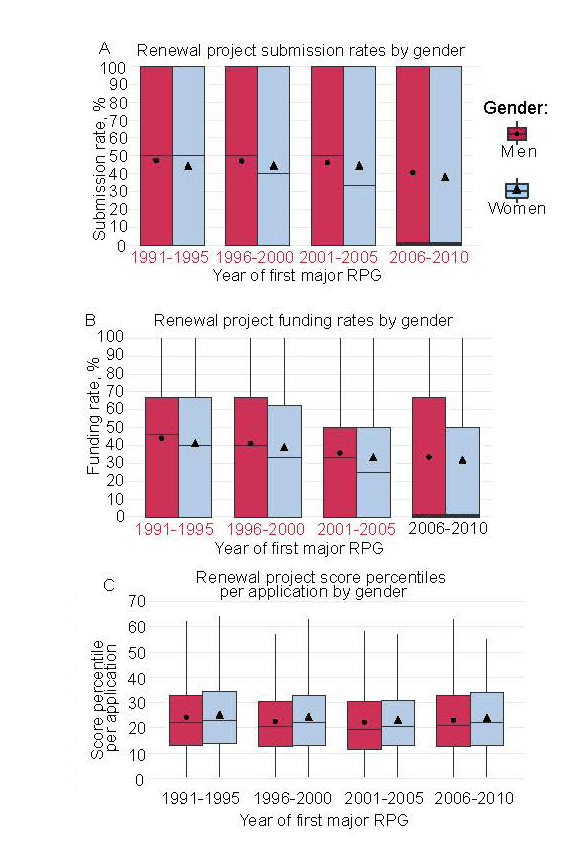9 Comments
For nearly 10 years, more women than men received PhDs in the biomedical sciences, yet women are still underrepresented at every subsequent stage of academic advancement. In 2015, for example, women earned 53% of PhDs, but they comprised only 48% of post-doctoral fellows, 44% of assistant professors, and 35% of professors.
To better understand what might be contributing to women’s underrepresentation in later stages of academia, Dr. Lisa Hechtman and her colleagues at the National Institute of General Medical Sciences (NIGMS) analyzed “funding longevity by gender” among funded NIH investigators. Their analysis, recently published in the Proceedings of the National Academy of Sciences, yielded a number of interesting findings which I’d like to share with you.
Our NIGMS colleagues started with 34,770 unique investigators who received their first major NIH research project grant (RPG) between 1991 and 2010. These supported investigators were followed over time to see how long they remained funded; if an investigator did not receive funding for 3 years in a row, they were considered to have dropped out of the funding pool.
The first key finding is that of the 34,770 unique investigators, only 10,660 of them (or 31%) were women. Even among the 9,969 investigators who first received funding between 2006 and 2010, only 3,342 (34%) were women.
Figure 1 Panel A shows a Kaplan-Meier survival plot of funding longevity by gender. Women had slightly less funding longevity, though at 25 years of follow-up the absolute difference was small – only 3.5%.

Figure 1
Figure 1 Panel B shows longevity for all investigators according to when they received their first RPG. Consistent with increasing hyper-competition, longevity was worse among more recent cohorts.

Figure 2
Figure 2 shows longevity by gender and by when investigators received their first RPG. For the first three time periods of first funding (1991-1995, 1996-2000, and 2001-2005), longevity was slightly less for women; for the last period of first funding (2006-2010) there was no difference.

Figure 3
Beyond a first grant (which typically lasts 5 years), a scientist’s funding longevity depends on securing new awards or successfully renewing existing awards. To gain a better understanding of why longevity was less for women, we see that in Figure 3 funded women submitted fewer new applications (Panel A); however, funding rates and peer review scores for new applications were no different for men and women (Panel C). The box plots in Figure 4 show the women sought project renewals less often (Panel A). In contrast to new applications, funding rates were lower (Panel B) and peer review scores were worse (Panel C) for women.

Figure 4
Many other correlates may also offer insight into women’s lower funding longevity, such as age, degree type, type of initial awards, year of first funding, and institutional characteristics. Using a machine learning approach, our colleagues identified renewal submission rate, new application submission rate, and funding per year as the variables which most strongly predicted funding longevity (data not shown). Of note, gender was “the least useful variable in predicting survival time.”
In summary, the authors found “only small differences in NIH funding longevity between genders.” The most “striking” difference was women’s initial underrepresentation. This “overwhelms all other gender differences that we report” – such as lower new application and renewal application rates and lower funding rates for renewal applications. The authors conclude that, despite the comparable longevities of funded men and women investigators, “broad gender differences remain, and that thoughtful intervention during key transitions such as those described could help reduce the differences.



mistake to interpret given data analyses. Questions first.
Are the number of new NIH applications equal by gender or proportional to the funding rate? (i.e. between 2006 and 2010, only 3,342 (34%) were women. How many new/early investigator applications were submitted by women?)
perhaps you could look at program directors eg residency and fellowship by gender and see if women apply less initially because they settle for “positions” in training and teaching which cover their RVUs but do not allow time for full-time research and therefore they drop out
Please show funding for Black/African American Women compared to (all) other women.
“The first key finding is that of the 34,770 unique investigators, only 10,660 of them (or 31%) were women. Even among the 9,969 investigators who first received funding between 2006 and 2010, only 3,342 (34%) were women.”
These numbers are absolutely meaningless if we do not know the percentage of women applicants. The critical numbers are the success rate between men and women, not the overall percentage funded. I would think NIH staff would know this.
Be careful! You’re not allowed to use too much logic, because the preconceived notions of “systemic oppression” must stand no matter what.
Please report on the fraction of women vs men whose renewal is funded on the first round (A0), versus those who must re-submit (A1). Reporting only on eventual success hides these statistics. When a renewal is not funded on the first round (particularly if it is the only grant funding the lab), the PI can be completely at the mercy of their Department Chair or Dean. They can be forced to fire personnel, they can be forced to take a pay cut, and their laboratory can even be closed. They can also lose stature in the eyes of the school, particularly if they are at a top research-intensive university. The effects can be quite damaging. From my informal calculations, it appears that far more women, proportionately, are getting their renewals with the A1 application. NIH has this data, so please report it.
Am I the only one who finds these Kaplan-Meier curves of continued funding horrifying? More than 60% of the initially funded investigators are not funded for 3 or more years after 15 years of research? What are these people, who are likely in their mid-50’s, doing? Are they on other people’s grants? Did they leave science, join the ranks of administrators, take jobs in companies or are they unemployed? Seems to me that this is a huge waste of scientific talent, and the NIH needs to figure out what is happening, if it doesn’t already know already, and what can be done.
Thank you for the suggestions for future analyses. If you are interested, we have additional data on funding by gender in the NIH Data Book (https://report.nih.gov/nihdatabook/index.aspx) under “Data by Gender” and in previous Open Mike blogs, Trends in Diversity within the NIH-funded Workforce (https://nexus.od.nih.gov/all/2018/08/07/trends-in-diversity-within-the-nih-funded-workforce/) and The Predictive Nature of Criterion Scores on Impact Score and Funding Outcomes (https://nexus.od.nih.gov/all/2016/07/22/the-predictive-nature-of-criterion-scores-on-impact-score-and-funding-outcomes/).